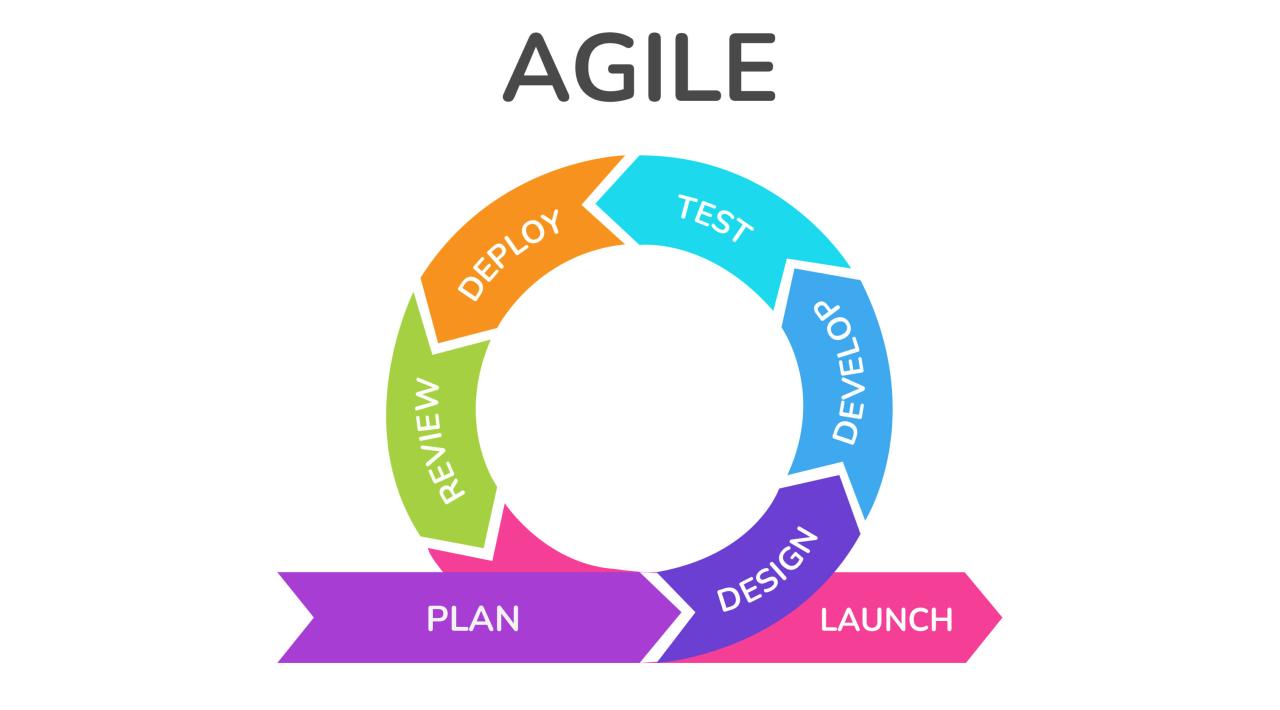Agile development has revolutionized the software industry, empowering teams to deliver high-quality products with speed and flexibility. This approach emphasizes collaboration, iterative development, and continuous feedback, fostering a dynamic environment where adaptation is key.
Table of Contents
This guide delves into the core principles, methodologies, and practices of agile development, providing a comprehensive understanding of its impact on project management, team dynamics, and software delivery.
Agile Development Principles

Agile development is a software development methodology that emphasizes iterative development, collaboration, and customer feedback. It aims to deliver working software in short cycles, allowing for flexibility and adaptation to changing requirements.
Core Values of Agile Development
The core values of Agile development are:
- Individuals and interactions over processes and tools: Agile development prioritizes the skills and collaboration of individuals over rigid processes and tools. This fosters creativity and problem-solving.
- Working software over comprehensive documentation: Agile teams focus on delivering functional software that meets user needs rather than extensive documentation. This allows for faster iterations and quicker feedback.
- Customer collaboration over contract negotiation: Agile development emphasizes ongoing communication and collaboration with customers to ensure the software meets their evolving needs.
- Responding to change over following a plan: Agile teams are flexible and adaptable, embracing change to deliver value to customers. This allows for quick adjustments based on feedback and market conditions.
The Agile Manifesto, Agile development
The Agile Manifesto is a document that Artikels the core values and principles of Agile development. It was created in 2001 by a group of software development practitioners who sought to address the limitations of traditional waterfall methodologies.
The Agile Manifesto emphasizes four core values:
- Individuals and interactions over processes and tools
- Working software over comprehensive documentation
- Customer collaboration over contract negotiation
- Responding to change over following a plan
The Agile Manifesto also includes 12 principles that guide Agile development practices. These principles emphasize iterative development, customer collaboration, continuous improvement, and a focus on delivering value.
Applying Agile Principles in Practice
Agile principles are applied in various ways in practice, including:
- Scrum: Scrum is a popular Agile framework that utilizes short iterations called sprints to deliver working software. It involves daily stand-up meetings, sprint planning, and sprint reviews to track progress and adapt to changes.
- Kanban: Kanban is a visual workflow management system that emphasizes continuous flow and improvement. It uses boards to visualize tasks and track progress, allowing teams to identify bottlenecks and optimize workflow.
- Extreme Programming (XP): XP is an Agile methodology that emphasizes pair programming, test-driven development, and continuous integration. It aims to deliver high-quality software through frequent iterations and close collaboration.
Agile Methodologies

Agile methodologies are a set of principles and practices that emphasize iterative development, collaboration, and continuous improvement. They are designed to help teams respond to changing requirements and deliver value quickly and efficiently.
Scrum
Scrum is a popular Agile framework that uses a series of short iterations called sprints to develop software. Each sprint typically lasts two to four weeks and involves a series of activities, including planning, daily stand-up meetings, sprint reviews, and retrospectives.
- Strengths: Scrum is highly adaptable and flexible, allowing teams to adjust to changing requirements. It also promotes collaboration and transparency, enabling teams to identify and address problems quickly.
- Weaknesses: Scrum can be challenging to implement effectively, requiring a high level of commitment from team members. It also requires a clear understanding of the product backlog and a well-defined sprint goal.
Scrum is well-suited for projects with complex requirements, frequent changes, and a need for rapid feedback.
Kanban
Kanban is a visual method for managing work that focuses on visualizing tasks and workflows. It uses a board with columns representing different stages of work, such as “To Do,” “In Progress,” and “Done.”
- Strengths: Kanban is simple and easy to implement, making it a good choice for teams that are new to Agile. It also provides a clear visual representation of work in progress, allowing teams to identify bottlenecks and improve workflow efficiency.
- Weaknesses: Kanban can be less structured than other Agile methodologies, making it difficult to track progress and ensure that work is completed on time. It also requires a strong focus on continuous improvement to be effective.
Kanban is well-suited for projects with a continuous flow of work, such as software maintenance or support.
Lean
Lean is a methodology that focuses on eliminating waste and maximizing value. It is based on the Toyota Production System, which emphasizes continuous improvement and reducing unnecessary steps in the production process.
- Strengths: Lean is highly effective at reducing waste and improving efficiency. It also promotes a culture of continuous improvement, encouraging teams to constantly look for ways to improve their processes.
- Weaknesses: Lean can be challenging to implement, requiring a significant change in mindset and culture. It also requires a deep understanding of the value stream and the ability to identify and eliminate waste.
Lean is well-suited for projects that require high efficiency and a focus on delivering value to customers.
Closing Summary: Agile Development

By embracing agile principles, organizations can unlock the potential for increased efficiency, improved customer satisfaction, and a competitive edge in today’s rapidly evolving technological landscape. As we conclude this exploration, remember that agile development is not just a methodology but a mindset, encouraging continuous learning, adaptation, and a relentless pursuit of excellence.
Agile development thrives on rapid iterations and constant feedback. This means that sometimes, even with the best intentions, data can get lost or corrupted. That’s where a tool like testdisk can be invaluable. It’s a powerful data recovery utility that can help you recover lost partitions or files, ensuring that your agile development process doesn’t suffer from data loss setbacks.
